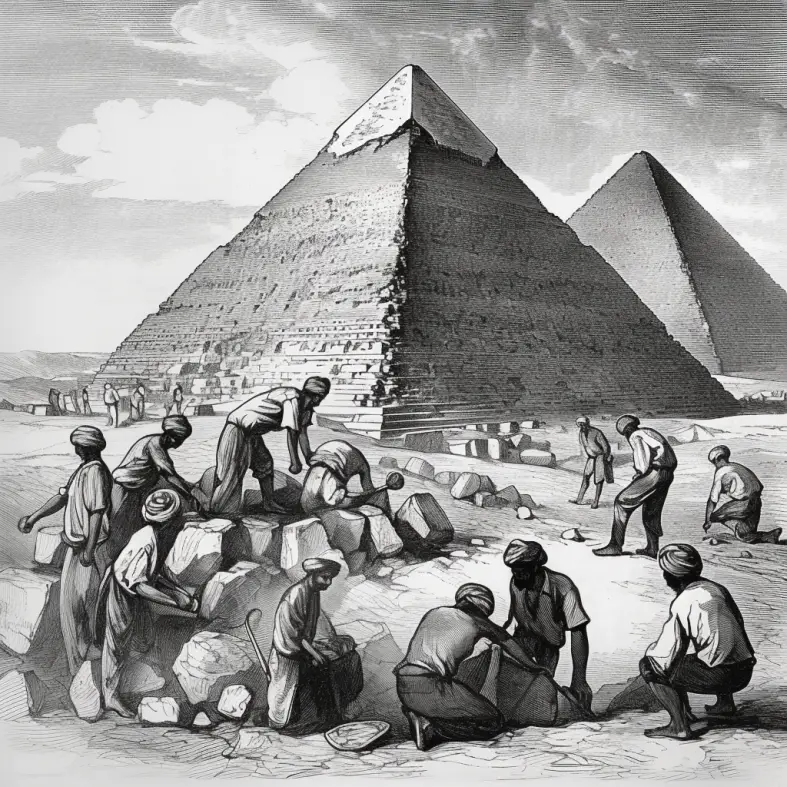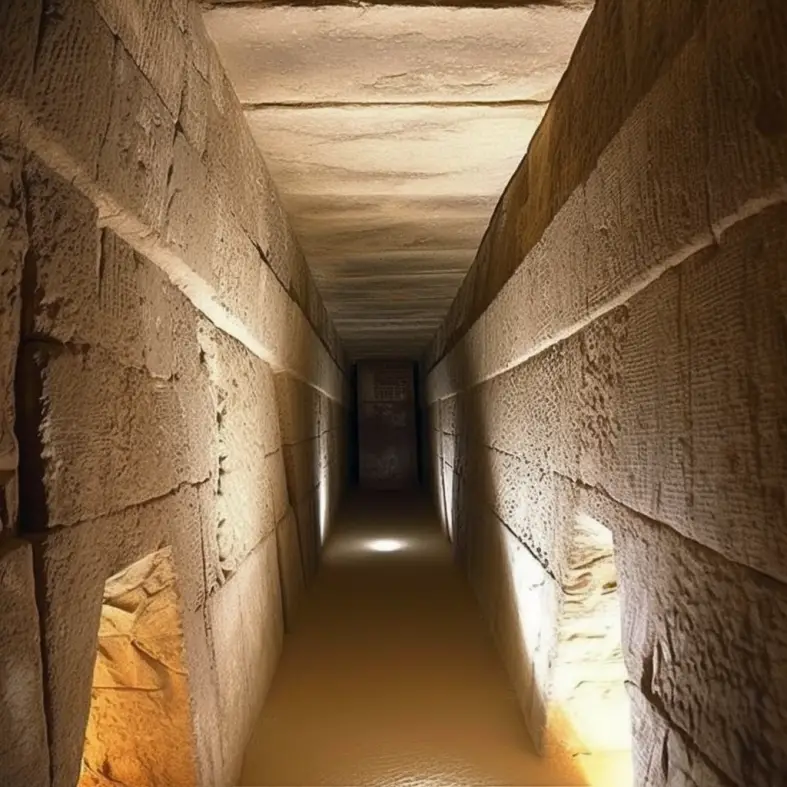Egyptian Pyramids
The pyramids that we see in Egypt today continue to be ‘Wonders of the World’. They were built thousands of years ago and yet still stand.
The ancient Egyptians created the pyramids as burial tombs to honor their pharaohs and since they believe them to be both man and god, they made the pyramids in a grand style.

The Evolution of Burial Tombs in Ancient Egypt
It’s believed that the original burial tombs for pharaohs and high-ranking officials were flat monuments called ‘mastabas’. Over the years, each new burial tomb would have another smaller layer added to the top until they began to look like steps.
The building of pyramids reached its height in the Old Kingdom time, between the Fourth and Sixth Dynasties; 2575 BC to 2150 BC. There are over 70 pyramids near the Nile River.
It is thought that the first smooth-sided pyramid was built between the years of 2680 to 2560 BC for the pharaoh King Snefru.
Who Built the Pyramids?
Archeological excavations have found that unlike what most people might think, the pyramids were not built by slaves, but were Egyptians that lived in the area.
They have found living areas that appear to be for the laborers and their families in an almost community style.
The villages seem to be set up with shops, houses, butcher shops, and even bakeries for the thousands of loaves of bread that were needed to feed the workers.
Building the Pyramids: Planning, Precision, and Logistics

There was a lot of planning that went into building a pyramid. Because of the weight, the location had to be on a firm rock because building on sand would cause it to collapse.
Specific measurements had to be made on the base size width and length. This was one of the most important decisions because if they were off, the pyramid would fall.
Rock was cut out from quarries that were often quite a distance and carried on boats on the River Nile to the pyramid location.
There were millions of pieces of rock that had to be just the right size to fit in place.
Building the Pyramids: An Ancient Engineering Enigma
Egyptologists are not really sure how the ancient Egyptians managed to get the heavy rock, often weighing many tons to build the pyramids.
Some think that they used ramps, while others think that they may have used sand to release and balance.
There are many people throughout the world today that have tried to build smaller pyramids to figure out exactly how it was done.
The Pyramids: Ancient Engineering Marvels
One of the things that everyone notices about the pyramids of Egypt is that they are incredibly large. The smallest of the Giza pyramids is over 200 ft high.
The pyramid built by the pharaoh Khufu (pronounced Koo-foo) was originally 480 ft high and is made up of over 2.3 million stone blocks.
Each of the blocks weighs about 5,000 lbs and had to be cut to the right size, brought to the pyramid, and put in place by hand.
The engineers of ancient Egypt were familiar with the difficult mathematics that were involved in creating a structure of such size.
Secret Chambers: Inside the Pyramids of Ancient Egypt

If building the pyramids isn’t enough of a challenge, the ancient Egyptian engineers planned the blocks so that there were inner chambers and tunnels.
It was thought that the pyramid chambers were for the burial of the pharaohs.
Some of the huge stone burial sarcophagus have been found inside the pyramids but never any of the mummies or anything that would have been buried with the pharaoh.
Pyramids: Ancient Marvels with a Timeless Appeal
Once a pyramid was completed, it had armed guards to try to protect it from tomb raiders.
The tombs were raided on such a regular basis that it is thought that the secrets were told to others by the builders.
If anyone was caught raiding a pharaoh’s tomb, it was an instant death sentence.
The pyramids that we see today have crumbled quite a bit and don’t look at all like they would have upon completion.
Once all of the stones were in place, the entire pyramid was covered in white limestone and the top or cap of the pyramid would have been tipped in gold.
In the bright Egyptian sunshine, the white and the gold would have gleamed brightly.
How many pyramids are there in Egypt?
Knowing exactly how many pyramids were built in Egypt is a challenge, as some were poorly made or small and have since fallen apart or been buried by sand.
However, the discovery of more pyramids continues to surprise us. Karl Richard Lepsius compiled a list of pyramids long ago and counted a total of 67. But since then, we have unearthed countless more pyramids, many of which are in poor condition or concealed by sand, making them appear like nothing more than piles of rocks.
It’s interesting to note that with the exception of one, all pyramids are located on the western side of the Nile River, and they tend to be clustered together in what is known as pyramid fields.
These magnificent structures have stood the test of time, and their sheer majesty continues to amaze us even after all these years.
The mystery of the pyramids continues to captivate us, and we can’t wait to see what other secrets they hold.
Abu Rawash
Abu Rawash boasts Egypt’s northernmost pyramid, the Pyramid of Djedefre, constructed for Pharaoh Khufu’s son.
Although now mostly in ruins, this pyramid was once among the largest in Egypt, comparable in size to the Pyramid of Menkaure. It’s unclear if the pyramid was ever completed, but its grandeur in its prime cannot be denied.
Giza
Giza, an ancient city in Egypt, is renowned for its pyramids including the Great Pyramid of Khufu, the Pyramid of Khafre, and the Pyramid of Menkaure. Additionally, there are smaller pyramids known as the Queen’s pyramids and the Great Sphinx of Giza.
The Great Pyramid is a must-visit as it is the only remaining one of the Seven Wonders of the Ancient World, making Giza a popular tourist destination.
Abusir
Abusir boasts 14 pyramids, serving as the primary burial location for royalty in the Fifth Dynasty. These pyramids are smaller and feature lower-quality limestone than their counterparts from the Fourth Dynasty.
Niuserre’s, Neferirkare Kakai’s, and Sahure’s pyramids are the largest at Abusir, with the unfinished Pyramid of Neferefre also present on site.
Dahshur
Dahshur, a crucial pyramid site in Egypt, remained obscure until 1996 due to its location within a military base.
It houses the Bent Pyramid, constructed for Sneferu, which was the first pyramid planned with smooth sides from the outset. The Meidum pyramid also boasts smooth sides but initially began as a step pyramid before being modified.
Despite its significance in Egyptian history, archaeologists were the only ones aware of Dahshur until it became accessible.
Lisht
Lisht, situated near the Faiyum oasis and approximately 100 kilometers south of Cairo, boasts two significant pyramids constructed for Pharaoh Amenemhat I and his son, Senusret I.
The Pyramid of Senusret I, surrounded by the debris of ten smaller pyramids, one of which belonged to Amenemhat’s cousin, Khaba II, stands tall in the Dahshur and Meidum burial grounds.
Additionally, it is believed to be in proximity to Itjtawy, Egypt’s capital during the Twelfth Dynasty.



